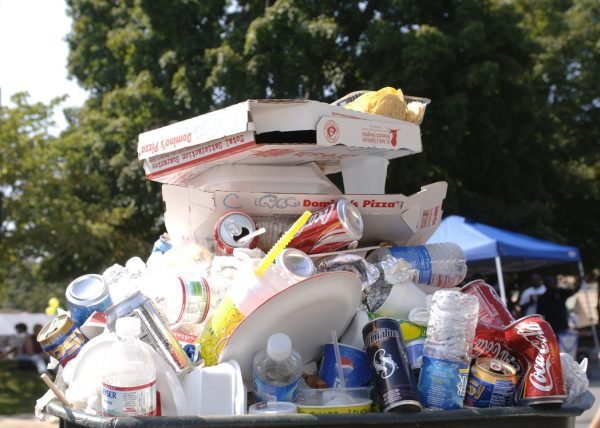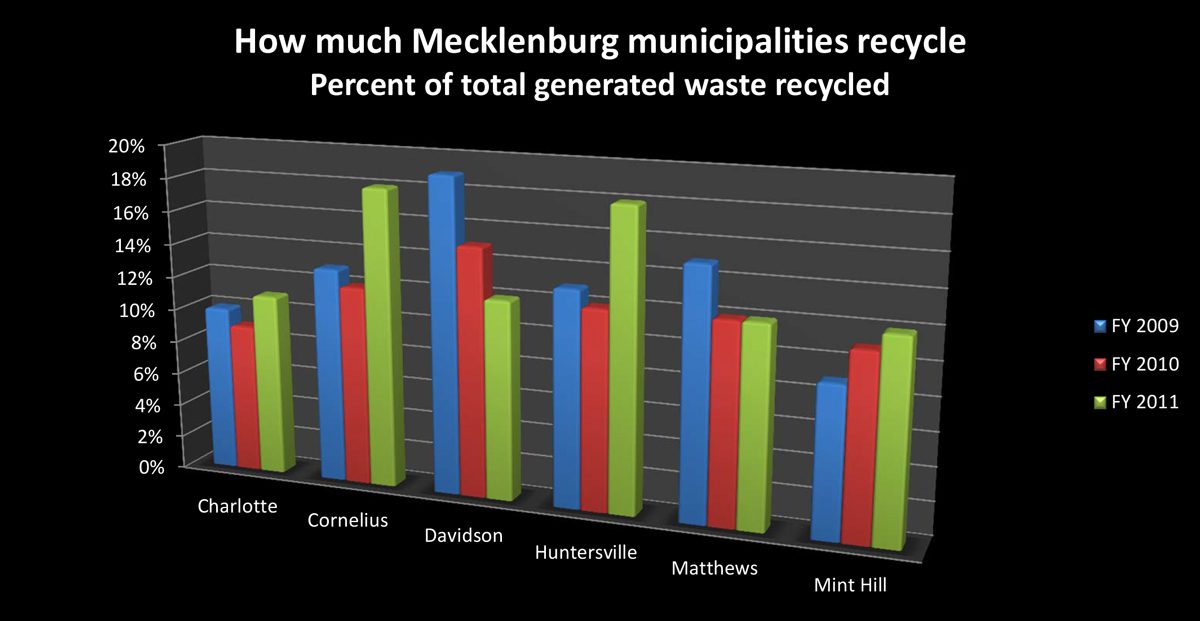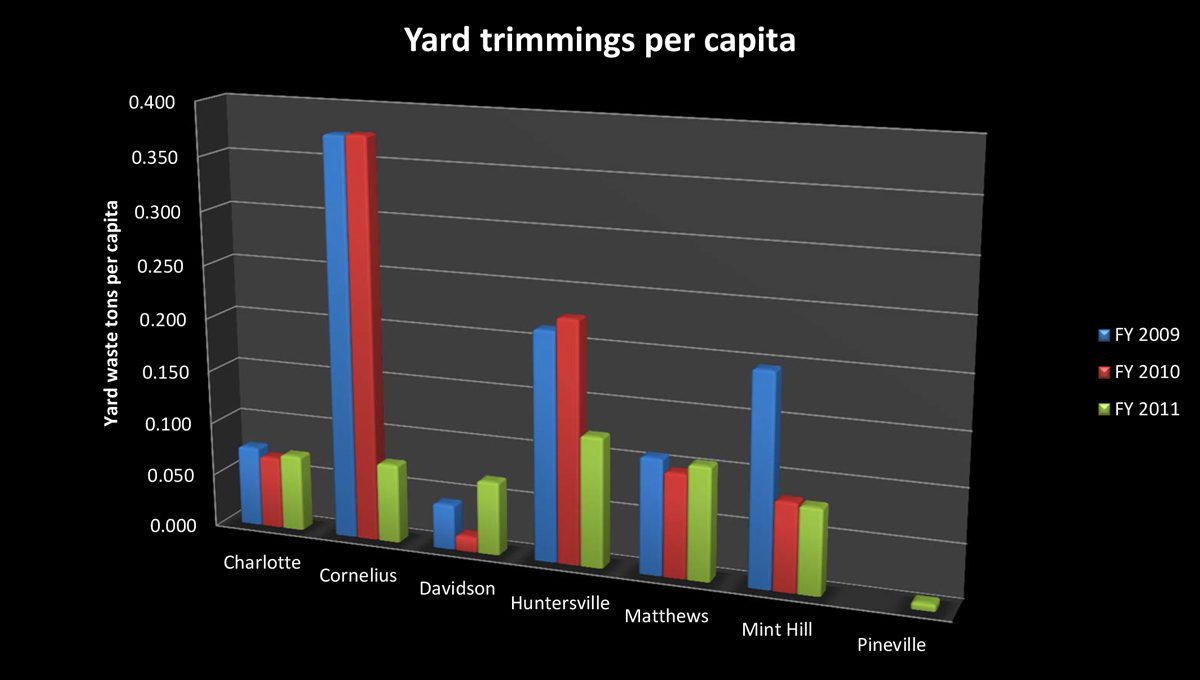The story behind your recycling bin

Tucked at the end of a dead-end street in an industrial area just north of uptown Charlotte, Mecklenburg’s recycling processing plant sits as a storyteller of the area’s challenges in figuring out how to reduce its dependence on landfills.
KEEPING WATCHThis article is part of the three-year KEEPING WATCH initiative. Learn more about the initiative at keepingwatch.org. Other articles: |
Workers in masks and earplugs sort items zooming by on conveyor belts, while dump trucks empty thousands of tons of paper, glass and plastic on a cavernous warehouse floor. Those materials represent a residential recycling rate of less than 20 percent, ranging from 11 to 18 percent for Charlotte and Mecklenburg County’s six towns in 2011. The county’s public schools, some of which started recycling milk cartons a few years ago, reached an estimated 19 percent rate that same year.
It is more difficult to determine how much businesses recycle, since they send their materials to other facilities and there is no state requirement that they report recycling figures, only how much garbage is dumped. Commercial waste in Mecklenburg far outweighs residential and construction and demolition debris, which compete for second place. County statistics show that in 2011, commercial waste, including yard trimmings, had dropped 46 percent since 1998.
 All the numbers reveal a complicated tale.
All the numbers reveal a complicated tale.
“We’re trying to come up with more ways to encourage people to recycle,” says Victoria Johnson, director of Charlotte’s solid waste services department. “Since we’re not affecting people’s pockets, it’s hard to get them to recycle more.”
Charlotte-Mecklenburg is making strides in recycling and reducing waste, nearly 30 years after the modern era of waste disposal and recycling began as a garbage barge from New York traveled two months in the Atlantic seeking a place to dump garbage and was first rejected in North Carolina’s Morehead City. In an area where landfill space has historically been plentiful and dumping fees are relatively low, reducing waste through recycling has not yet taken on the urgency that surrounds government-run programs in larger cities.
But with steady population growth and decreasing space for landfills, officials are likely to face greater challenges in the future if residents and business just throw trash “away.” It took 15 years to win approval for the last, and only county-owned operating landfill, sited in what was once a largely rural area that has transformed into the fast-growing Ballantyne area.
Recycling for single-family homeowners is voluntary. While local governments also encourage residents in apartments and condos to recycle, they don’t require multifamily communities to provide recycling collection services. Most small businesses don’t fall under a local ordinance requiring office paper and corrugated cardboard to be recycled. State law doesn’t require larger businesses to report the amount they send to recycling facilities.
Residents in both single-family homes and multifamily complexes pay a $45 annual fee for solid waste disposal, along with property taxes. But for small businesses that generate less than 512 gallons of garbage a week, Charlotte provides garbage collection service and assesses no solid waste disposal fee.
County solid waste officials say they regularly evaluate the recycling program for ways to strengthen it and to get more participation from residents and businesses.
On example: Officials recently tested a program that would have banned residents from putting aluminum cans and bottles in garbage cans. State law forbids putting those items into landfills. But they ended the effort after a state law enacted last year said local environmental ordinances couldn’t be more stringent than state law.
Other examples: A food waste collection program began two years ago in several public schools. And a 10-year Charlotte-Mecklenburg solid waste management plan recommends considering moving to mandatory recycling and to volume-based pay for garbage collection
“Right now, we have opportunity,” says Joe Hack, a senior environment engineer with Mecklenburg County Solid Waste Services. “The decision-makers are going to have to make the decisions.”
Officials say the county has reached some milestones.
- In 1998, Mecklenburg County disposed of 1.96 tons of waste per person in landfills; in 2013, the per-person rate was down to 0.98 ton.
- A $7 million upgrade at the county-owned recycling processing plant nearly four years ago allowed more types of things to be recycled in Charlotte-Mecklenburg’s recycling program. The recycled tonnage increased 25 percent.
- An estimated 56 percent of Mecklenburg households participate in curbside recycling, with 31 percent recycling every collection day. Participation varies around the county, however, with higher participation in more affluent areas.
“We’re doing better than expected,” says Laurette Hall, the environmental manager of the county solid waste services. Officials had not anticipated the 50 percent reduction since 1998 in the per capita rate of garbage sent to landfills. The reduction resulted in part from a significantly less construction debris during the recession, as well as more increase in residential and business recycling.
Still, Charlotte-Mecklenburg lags other areas of the country, according to a study by Sustain Charlotte, a nearly four-year-old advocacy group focusing on sustainability issues.
Mecklenburg’s per person recycling rate is 62 percent lower than the national average, the study found. County residents recycled, on average, 0.44 pounds of waste per day in 2011-12. The national average was 1.16 pounds. The study also showed that Mecklenburg residents sent 85.1 percent of waste to the landfill in 2011-12, compared to a national average of 54 percent.
“While some residents and business owners already recycle because they understand the long-term benefits of doing so, overall recycling rates are low because there is no financial incentive to recycle,” says Meg Fencil, education and outreach program director for Sustain Charlotte. “Cities that have mandatory recycling or use a ‘pay as you throw’ approach have seen an increase in recycling rates.”
What about landfill space?
Ultimately, Charlotte-Mecklenburg’s goal is to reduce the environmental impact of waste disposal and the need for more landfill space.
Waste reduction efforts include collecting yard trimmings, which are turned into landscaping mulch, compost or boiler biofuel – primarily as a result of an early 1990s state ban on putting tree limbs, leaves and other yard trash in landfills. In 2011, the county handled 98,279 tons of trimmings, nearly 8 percent of the total waste generated. Businesses must collect and process their own yard trimmings and do not have to report what they generate.

As a result of state bans on what can be dumped in landfills, the county offers a network of full-service and drop-off recycling centers for electronics, household hazardous waste, batteries and tires as well recyclable items.
Today, Mecklenburg County, which is responsible for disposing of waste for Charlotte and the six county towns, sends all residential garbage to the 729-acre Charlotte Motor Speedway Landfill in Cabarrus County. The contract for service there ends in 2022 and must be renegotiated. The county’s cost, $39 a ton, is relatively low compared to other, more urban cities.
Affluent south Charlotte is the site of the only county-owned operating landfill, the Foxhole Landfill on US 521 in the Ballantyne area. The 563-acre landfill opened in 2000 after a 15-year effort to get a state permit and is used only for construction debris. County officials, working with a citizen advisory board, some of whom opposed the landfill, have agreed to divert municipal garbage away from the Foxhole location as long as possible.
“Foxhole is likely to be the last county-owned landfill,” says Hall. “There is not enough land for another landfill. There are simply not the sites available.”
Officials say that the Speedway and Foxhole landfills have the disposal capacity to handle current municipal waste generation rates for the next few decades.
Eight other landfills outside Mecklenburg receive garbage from county businesses and other institutions. But as landfill space fills up and dumping fees rise, elected officials will face growing pressure to increase recycling and to consider other methods of waste disposal, such as using garbage to generate electricity.
Recycling pizza boxes and more
The recent decision to allow pizza boxes in Charlotte-Mecklenburg’s curbside recycling program sparked a hearty hooray from residents, surprising solid waste officials. The change encourages residents to do what many have been doing anyway: dumping pizza boxes into the recycle bin along with other cardboard.
“People love it,” says Hall. “It took off like wildfire.”
The pizza box ban had been one of many perplexing recycling rules governing which products are allowed and which are banned in the county recycling program. The city regularly gets complaints about recycling rules, particularly from residents moving here from cities with more recycling options.
City and county officials publish brochures, provide online information and, a few months ago, launched a Curb It! app for mobile devices to help spread the word about recycling.
But they say they are considering more aggressive educational efforts.
Here are a few recycling mysteries, solved. Click here to see more questions answered.
Why weren’t pizza boxes allowed until recently? Oil residue from the cheese contaminates other recyclable paper during processing and makes it harder to use the paper for new products. But now that problem has been solved.
Does it matter if food residue is left in glass containers? It does, say county officials. They say the county’s recycling equipment functions better when residents scrape out the peanut butter or mayonnaise.
Does it matter if wet paper or cardboard is tossed in the recycling bin? Yes. Wet paper is harder for the processing equipment to handle.
What the county accepts in its curbside recycling program has increased over the past few years after a change to single-stream recycling in 2010 and continued expansion as a result of new technologies in how vendors can process recyclable items for new products. For residents, the move to single-stream meant more convenience: No more separating items, as everything can be tossed into one large bin. Along with the overhaul, which included a multimillion upgrade in the county recycling processing facility, officials created a new promotional campaign for recycling.
In January, the city debuted the Curb It! mobile app offering information on what’s recyclable, collection days, location of drop-off recycling centers and other information. In the first three weeks, there were nearly 300 subscribers, surpassing the surpassed the response to other apps introduced by other city departments.
“We see as we educate people about recycling,” says Johnson, the city’s solid waste director, “the numbers are climbing.”